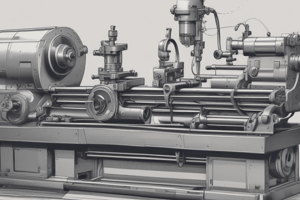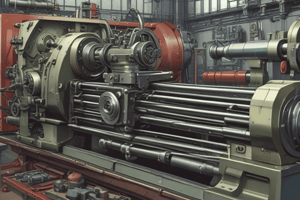Podcast
Questions and Answers
What is the primary purpose of turning operation in a lathe?
What is the primary purpose of turning operation in a lathe?
- To produce a flat surface at the end of the workpiece
- To produce a regularly shaped roughness on the workpiece
- To produce external or internal threads on the workpiece
- To remove material from the outside diameter of a workpiece (correct)
What is the cutting tool used in turning operation?
What is the cutting tool used in turning operation?
- Facing Tool
- Turning Tool (correct)
- Drilling Tool
- Knurling Tool
What is the purpose of facing operation in a lathe?
What is the purpose of facing operation in a lathe?
- To produce a hole on the workpiece
- To produce external or internal threads on the workpiece
- To produce a flat surface at the end of the workpiece (correct)
- To remove material from the outside diameter of a workpiece
What is the purpose of drilling operation in a lathe?
What is the purpose of drilling operation in a lathe?
What is the purpose of reaming operation in a lathe?
What is the purpose of reaming operation in a lathe?
What is the purpose of threading operation in a lathe?
What is the purpose of threading operation in a lathe?
What is the purpose of knurling operation in a lathe?
What is the purpose of knurling operation in a lathe?
What is the purpose of parting operation in a lathe?
What is the purpose of parting operation in a lathe?
What is the purpose of grooving operation in a lathe?
What is the purpose of grooving operation in a lathe?
What is the purpose of chamfering operation in a lathe?
What is the purpose of chamfering operation in a lathe?
Flashcards are hidden until you start studying
Study Notes
Working Principle of Lathe
- The tool moves parallel to the workpiece's cylindrical surface to form a cylindrical surface.
- The tool moves inclined to the axis to produce a taper surface, called taper turning.
- The work is held between two supports called centers, or by a chuck or face plate mounted on the machine spindle.
- The cutting tool is held and supported on a tool post.
- The job moves in rotation about the spindle axis, and the tool is fed against the revolving work.
- The tool movement can be either parallel to or at any inclination to the work axis.
Specifications of Lathe
- Height of centers, type of bed (straight, semi-gap, or gap), and center distance.
- Swing over bed, swing over cross slide, swing in gap, and gap in front of face plate.
- Spindle speeds range, spindle nose, spindle bore, and taper nose.
- Metric thread pitches, lead screw pitch, longitudinal feeds, and cross feeds.
- Cross slide travel, top slide travel, and tool section.
- Tailstock sleeve travel, taper in sleeve bore, and motor horsepower and RPM.
- Shipping dimensions including length, width, height, and weight.
Types of Lathes
- Engine Lathe or Center Lathe: most common type, widely used in workshops, and allows for variable spindle speed.
- Bench Lathe: small, mounted on a workbench, used for making small, precision, and light jobs.
- Speed Lathe: high-speed, hand-operated, used for wood turning, metal spinning, and other operations, with a spindle speed of 1200 to 3600 rpm.
- Tool Room Lathe: designed for accuracy, used for manufacturing precision components, dies, tools, jigs, etc.
- Special Purpose Lathes: custom-tailored for particular needs, used for heavy-duty jobs, and includes types like Gap Lathe, Instrument Lathe, Facing Lathe, Flow Turning Lathe, Heavy Duty Lathe, and more.
- Turret Lathe: an adaptation of the engine lathe, where the tail stock is replaced by a turret slide, and the tool post is replaced by a cross slide.
- Capstan Lathe: similar to turret lathe, but with a movable turret, used for fast production of small parts.
- Automatic Lathe: a lathe where the workpiece is automatically fed without operator intervention, requiring minimal attention after setup.
- CNC Lathe: a high-tech lathe with a computer numeric control system (CNC), allowing for automatic tool change, high accuracy, and fast production.
Lathe Operations
- Turning: to remove material from the outside diameter of a workpiece to obtain a finished surface.
- Facing: to produce a flat surface at the end of the workpiece or for making face grooves.
- Boring: to enlarge a hole or cylindrical cavity made by a previous process or to produce circular internal grooves.
- Drilling: to produce a hole on the workpiece.
- Reaming: to finish the drilled hole.
- Threading: to produce external or internal threads on the workpiece.
- Knurling: to produce a regularly shaped roughness on the workpiece.
- Parting: to cut the workpiece into two, similar to grooving.
- Chamfering: to bevel sharp machined edges, making assembly easier and improving aesthetics.
- Drilling: a process of creating a hole on the workpiece having a certain depth.
Studying That Suits You
Use AI to generate personalized quizzes and flashcards to suit your learning preferences.




